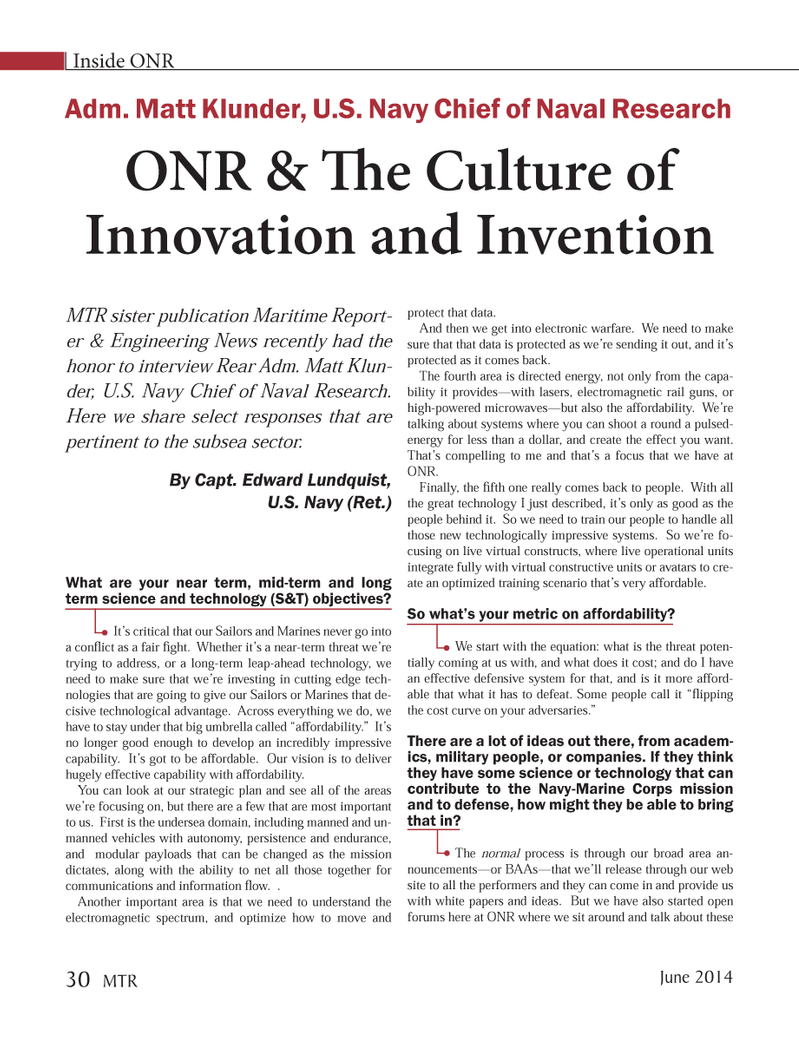
Page 30: of Marine Technology Magazine (June 2014)
Hydrographic Survey
Read this page in Pdf, Flash or Html5 edition of June 2014 Marine Technology Magazine
Inside ONR
MTR sister publication Maritime Report- er & Engineering News recently had the honor to interview Rear Adm. Matt Klun- der, U.S. Navy Chief of Naval Research.
Here we share select responses that are pertinent to the subsea sector.
By Capt. Edward Lundquist,
U.S. Navy (Ret.)
What are your near term, mid-term and long term science and technology (S&T) objectives? It’s critical that our Sailors and Marines never go into a confl ict as a fair fi ght. Whether it’s a near-term threat we’re trying to address, or a long-term leap-ahead technology, we need to make sure that we’re investing in cutting edge tech- nologies that are going to give our Sailors or Marines that de- cisive technological advantage. Across everything we do, we have to stay under that big umbrella called “affordability.” It’s no longer good enough to develop an incredibly impressive capability. It’s got to be affordable. Our vision is to deliver hugely effective capability with affordability.
You can look at our strategic plan and see all of the areas we’re focusing on, but there are a few that are most important to us. First is the undersea domain, including manned and un- manned vehicles with autonomy, persistence and endurance, and modular payloads that can be changed as the mission dictates, along with the ability to net all those together for communications and information fl ow. .
Another important area is that we need to understand the electromagnetic spectrum, and optimize how to move and protect that data.
And then we get into electronic warfare. We need to make sure that that data is protected as we’re sending it out, and it’s protected as it comes back.
The fourth area is directed energy, not only from the capa- bility it provides—with lasers, electromagnetic rail guns, or high-powered microwaves—but also the affordability. We’re talking about systems where you can shoot a round a pulsed- energy for less than a dollar, and create the effect you want.
That’s compelling to me and that’s a focus that we have at
ONR.
Finally, the fi fth one really comes back to people. With all the great technology I just described, it’s only as good as the people behind it. So we need to train our people to handle all those new technologically impressive systems. So we’re fo- cusing on live virtual constructs, where live operational units integrate fully with virtual constructive units or avatars to cre- ate an optimized training scenario that’s very affordable.
So what’s your metric on affordability? We start with the equation: what is the threat poten- tially coming at us with, and what does it cost; and do I have an effective defensive system for that, and is it more afford- able that what it has to defeat. Some people call it “fl ipping the cost curve on your adversaries.”
There are a lot of ideas out there, from academ- ics, military people, or companies. If they think they have some science or technology that can contribute to the Navy-Marine Corps mission and to defense, how might they be able to bring that in? The normal process is through our broad area an- nouncements—or BAAs—that we’ll release through our web site to all the performers and they can come in and provide us with white papers and ideas. But we have also started open forums here at ONR where we sit around and talk about these
ONR & Th e Culture of
Innovation and Inventiontio ventio
Adm. Matt Klunder, U.S. Navy Chief of Naval Research 30 MTR
June 2014
MTR #5 (18-33).indd 30 6/9/2014 10:22:21 AM

 29
29

 31
31
